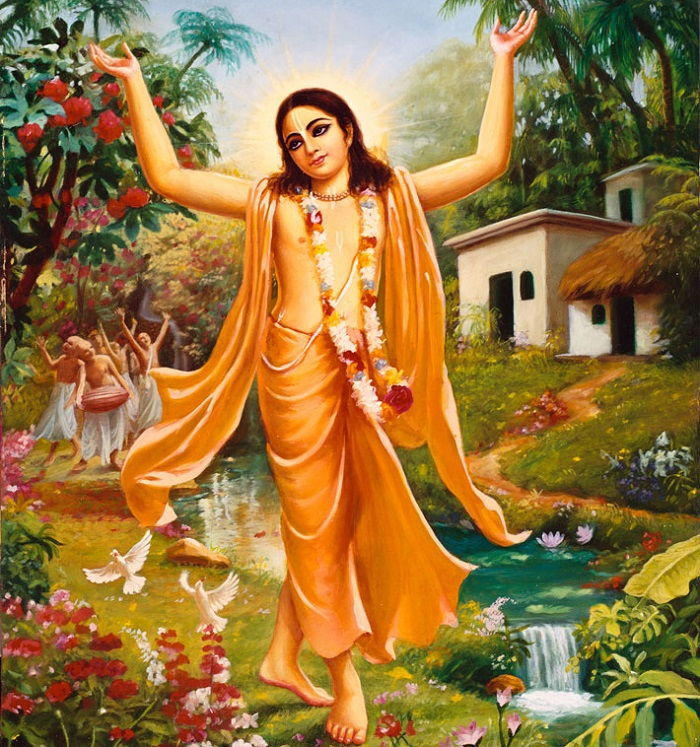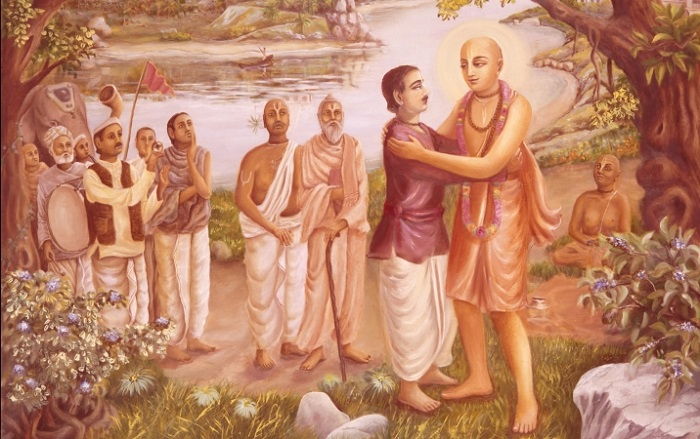There will be a discourse on the Life & Teachings of Sri Gauranga Mahaprabhu after evening arati by Swami Aparokshananda on 25.03.2024.
Life of Sri Gauranga Mahaprabhu
Birth: 18 February 1486
Place: Nabadwip, West Bengal, India
Death: 14 June 1534
Father: Jagannath Mishra
Mother: Sachi Devi
Guru: Ishvara Puri
Chaitanya Mahaprabhu was a 15th century Vedic spiritual leader, who is considered an avatar of Lord Krishna by his followers. Chaitanya founded Gaudiya Vaishnavism, which is a religious movement that promotes Vaishnavism or worship of Lord Vishnu as the Supreme Soul. Gaudiya Vaishnavism teaches the acceptance of Bhakti yoga as a method to realize the ultimate truth. Chaitanya Mahaprabhu is credited with popularizing the ‘Maha Mantra’ or ‘Hare Krishna Mantra.’ He is also known for composing in Sanskrit a prayer of eight verses, known as ‘Siksastakam.’ Said to have been born with features similar to that of Lord Krishna, Chaitanya Mahaprabhu was a child prodigy, and became a scholar at a very young age. He even opened a school and had thousands of followers very early in his life. Though not much about his sudden and mysterious disappearance or demise is known, a few scholars and researchers believe that he might have died of epilepsy. However, this conclusion is still debatable as there are other accounts that suggest various other theories, including a theory of murder and magical disappearance.

Childhood & Early Life
Chaitanya was born Vishvambhar on February 18, 1486. At the time of his birth, India witnessed a full lunar eclipse, which was considered auspicious by Hindu scholars. Chaitanya was the second born child of Sachi Devi and her husband Jagannath Mishra. He had an elder brother, Visvarupa, and the entire family lived in Srihatta, in present-day Sylhet, Bangladesh.
Many sources state that Chaitanya was born with a fair skin and had striking similarities with the conceived image of Lord Krishna. As a young boy, Chaitanya started chanting praises of Lord Krishna and also exhibited unusually high level of intelligence. He could recite mantras and other religious hymns at a very young age, and had gradually started spreading knowledge much like a scholar.
When he was 16 years old, Chaitanya started his own school, which attracted many pupils. Chaitanya’s knowledge and wisdom was so great that he once defeated a proud and learned scholar named Keshava Kashmiri in a debate. The next day Keshava Kashmiri is said to have surrendered before Chaitanya, accepting his defeat gladly. According to various sources, Keshava Kashmiri dreamt of Goddess Saraswati on the night after the debate. When Goddess Saraswati explained to him who Chaitanya actually was, Keshava Kashmiri realized the truth and accepted defeat the next morning.

Chaitanya Meets Ishvara Puri
After the demise of his father, Jagannath Mishra, Chaitanya visited the ancient city of Gaya to perform a religious ceremony to pay homage to his deceased father. While in Gaya, he met an ascetic named Ishvara Puri, who would go on to become Chaitanya’s guru. When Chaitanya returned to his hometown, there was a significant change in his thought process. He was followed by the local Vaishnavas of Bengal and it did not take him long before heading one of the Vaishnava groups in Nadia district.
Thereafter, he decided to leave Bengal and requested Keshava Bharati to bestow upon him ‘sannyasa,’ which requires one to renounce all things material and wander in search of the ultimate truth. While ascetics (sanyasi) follow various methods to attain salvation, Chaitanya’s key to unlock the ultimate truth was Bhakti yoga, which is one’s loving devotion towards the ‘Supreme Being.’ By chanting Lord Krishna’s name relentlessly, Chaitanya not only practiced Bhakti yoga, but also taught his followers the proper method of pursuing Bhakti yoga.
The Tour
For many years, Chaitanya travelled the length and breadth of India, advocating Bhakti yoga. Chanting the name of Krishna, Chaitanya would travel on foot to various places in a state of absolute bliss or ecstasy. In 1515, Chaitanya visited Vrindavan, believed to be the birth place of Lord Krishna. The main objective of Chaitanya’s visit was later said to be ‘reinvention,’ as Chaitanya wanted to identify important places associated with Lord Krishna, in Vrindavan.
It is said that Chaitanya was successful in locating all the important places, including the seven temples (sapta devalay), which are visited by Vaishnavas even today. After traveling for years, Chaitanya settled down in Puri, Odisha, where he stayed for the final 24 years of his life. Chaitanya was revered as Krishna himself not just by his ardent devotees and followers, but also by several rulers of the 16th century. Prataprudra Dev, a Gajapati ruler, became one of his most enthusiastic patrons and a devotee of his ‘sankeertan’ gatherings.

Teachings
‘Siksastakam,’ a 16th century prayer of eight verses, is the only written record of Chaitanya Mahaprabhu’s teachings. The teachings and philosophy of Gaudiya Vaishnavism are based on this Sanskrit text. Chaitanya Mahaprabhu’s teachings are divided into 10 points and are centered on the glorification of Lord Krishna.
Source: https://learn.culturalindia.net/chaitanya-mahaprabhu.html







